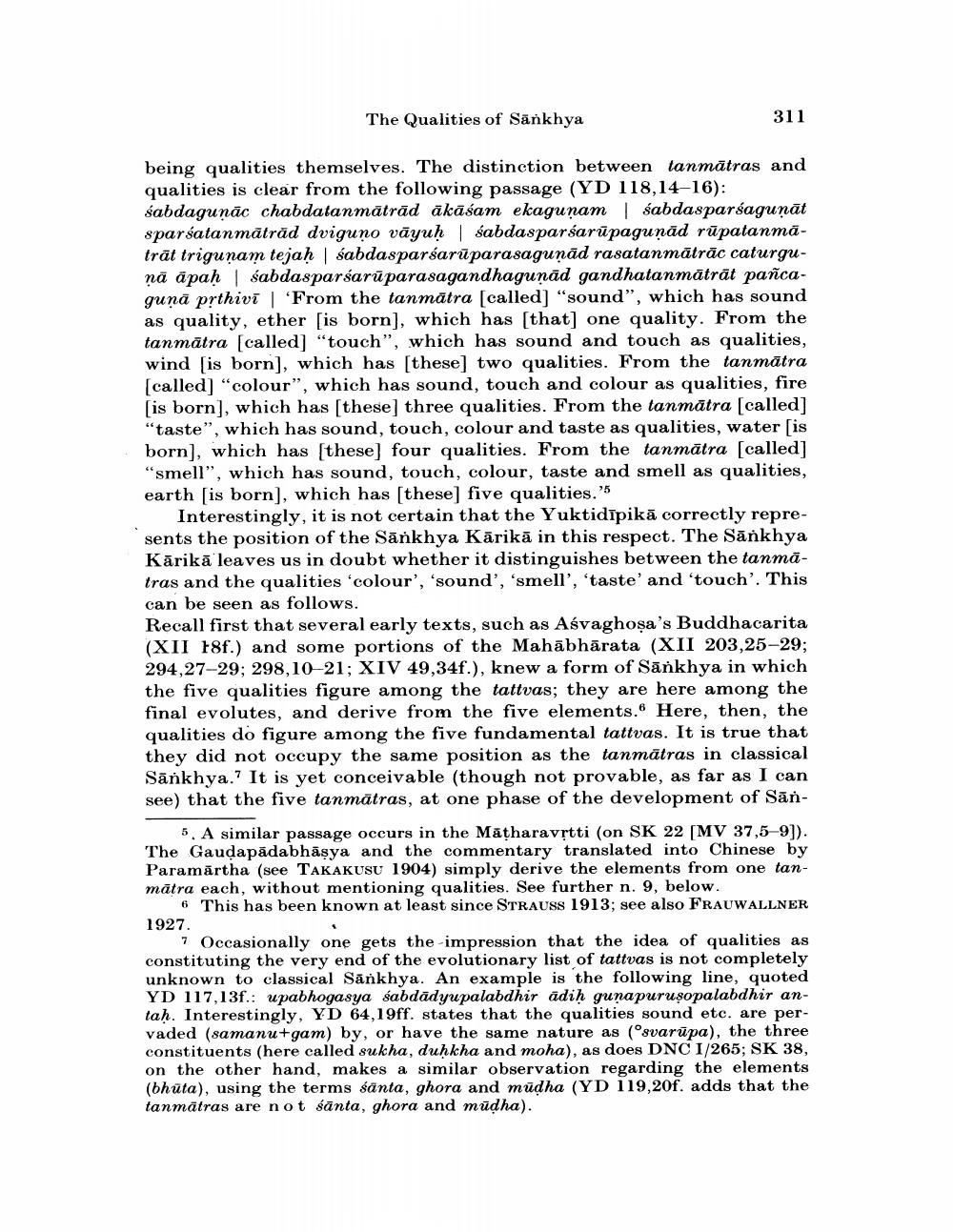________________
The Qualities of Sānkhya
311
being qualities themselves. The distinction between tanmātras and qualities is clear from the following passage (YD 118,14-16): sabdagunāc chabdatanmātrād ākāśam ekaguņam | sabdasparsagunāt sparsatanmātrād dviguno vāyuḥ śabdasparsarūpaguņād rūpatanmatrāt trigunam tejah | sabdasparsarūparasaguņād rasatanmātrāc caturgunā āpah sabdasparsarūparasagandhaguņād gandhatanmātrāt pañcaguņā prthivi | 'From the tanmātra [called] "sound", which has sound as quality, ether [is born), which has [that] one quality. From the tanmātra [called] "touch", which has sound and touch as qualities, wind [is born), which has [these] two qualities. From the tanmātra [called] "colour", which has sound, touch and colour as qualities, fire [is born), which has [these] three qualities. From the tanmātra [called] "taste", which has sound, touch, colour and taste as qualities, water is born), which has [these four qualities. From the tanmātra [called] "smell", which has sound, touch, colour, taste and smell as qualities, earth [is born), which has [these] five qualities. '5
Interestingly, it is not certain that the Yuktidīpikā correctly represents the position of the Sänkhya Kārikā in this respect. The Sānkhya Kārikā leaves us in doubt whether it distinguishes between the tanmatras and the qualities 'colour', 'sound', 'smell', 'taste' and 'touch'. This can be seen as follows. Recall first that several early texts, such as Ašvaghoşa's Buddhacarita (XII 18f.) and some portions of the Mahābhārata (XII 203,25-29; 294,27-29; 298,10-21; XIV 49,34f.), knew a form of Sānkhya in which the five qualities figure among the tattvas; they are here among the final evolutes, and derive from the five elements. Here, then, the qualities do figure among the five fundamental tattvas. It is true that they did not occupy the same position as the tanmātras in classical Sankhya. It is yet conceivable (though not provable, as far as I can see) that the five tanmätras, at one phase of the development of San
5. A similar passage occurs in the Mătharavrtti (on SK 22 [MV 37.5-91). The Gaudapādabhāsya and the commentary translated into Chinese by Paramărtha (see TAKAKUSU 1904) simply derive the elements from one tanmātra each, without mentioning qualities. See further n. 9, below.
6 This has been known at least since STRAUSS 1913; see also FRAUWALLNER 1927.
7 Occasionally one gets the impression that the idea of qualities as constituting the very end of the evolutionary list of tattvas is not completely unknown to classical Sānkhya. An example is the following line, quoted YD 117,13f.: upabhogasya sabdădyupalabdhir ādih gunapurusopalabdhir antah. Interestingly, YD 64,19ff. states that the qualities sound etc. are pervaded (samanu+gam) by, or have the same nature as (svarūpa), the three constituents (here called sukha, duhkha and moha), as does DNC 1/265; SK 38, on the other hand, makes a similar observation regarding the elements (bhuta), using the terms sänta, ghora and mūdha (YD 119,20f. adds that the tanmätras are not sānta, ghora and mūdha).




